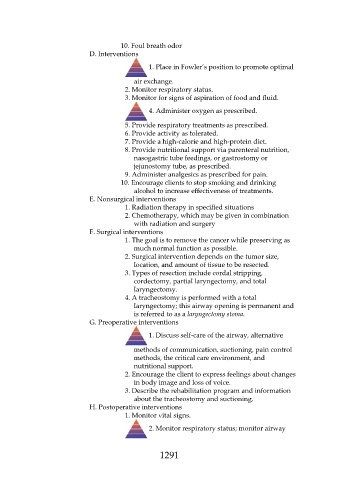Page 1291 - Saunders Comprehensive Review For NCLEX-RN
P. 1291
10. Foul breath odor
D. Interventions
1. Place in Fowler’s position to promote optimal
air exchange.
2. Monitor respiratory status.
3. Monitor for signs of aspiration of food and fluid.
4. Administer oxygen as prescribed.
5. Provide respiratory treatments as prescribed.
6. Provide activity as tolerated.
7. Provide a high-calorie and high-protein diet.
8. Provide nutritional support via parenteral nutrition,
nasogastric tube feedings, or gastrostomy or
jejunostomy tube, as prescribed.
9. Administer analgesics as prescribed for pain.
10. Encourage clients to stop smoking and drinking
alcohol to increase effectiveness of treatments.
E. Nonsurgical interventions
1. Radiation therapy in specified situations
2. Chemotherapy, which may be given in combination
with radiation and surgery
F. Surgical interventions
1. The goal is to remove the cancer while preserving as
much normal function as possible.
2. Surgical intervention depends on the tumor size,
location, and amount of tissue to be resected.
3. Types of resection include cordal stripping,
cordectomy, partial laryngectomy, and total
laryngectomy.
4. A tracheostomy is performed with a total
laryngectomy; this airway opening is permanent and
is referred to as a laryngectomy stoma.
G. Preoperative interventions
1. Discuss self-care of the airway, alternative
methods of communication, suctioning, pain control
methods, the critical care environment, and
nutritional support.
2. Encourage the client to express feelings about changes
in body image and loss of voice.
3. Describe the rehabilitation program and information
about the tracheostomy and suctioning.
H. Postoperative interventions
1. Monitor vital signs.
2. Monitor respiratory status; monitor airway
1291

